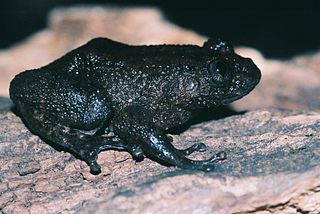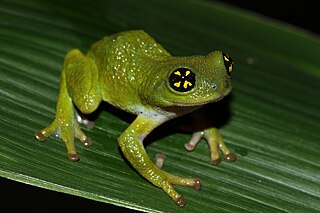
The purple frog, Indian purple frog, or pignose frog is a frog species of the genus Nasikabatrachus. It is endemic to the Western Ghats in India. Although the adult frog was formally described in October 2003, the juvenile form of the species was described earlier in 1917.

Nyctibatrachus is a genus of frogs endemic to the Western Ghats of southwestern India. Their common name is night frogs. Their scientific name also means "night frog", in reference to their habits and dark color. They are the only extant members of the monotypic subfamily Nyctibatrachinae. Currently, 35 species belong to Nyctibatrachus.

The Malabar gliding frog or Malabar flying frog is a rhacophorid tree frog species found in the Western Ghats of India.

Minervarya keralensis is a species of frog from India. Originally described by Albert Günther in 1876, its present-day specific epithet, keralensis, meaning "of Kerala", was introduced as replacement name by Alain Dubois in 1981.
Minervarya sauriceps is a species of frog that is endemic to the Western Ghats, India. It is only known from its type locality, Wattekole in Kodagu district, Karnataka state.
Minervarya syhadrensis, commonly known as long-legged cricket frog, Syhadra frog, Bombay wart frog, and many others, is a species of frog in the family Dicroglossidae found in India, Bangladesh, and Nepal at low to moderate elevations. It is the type species of genus Minervarya. In view of its wide distribution and stable population trend, IUCN assessors listed it as Least Concern in 2009 and 2016.

Indosylvirana aurantiaca, commonly known as the golden frog, is a species of frog endemic to the Western Ghats of India. The species is also known as the Trivandrum frog, the common wood frog, or the small wood frog.

Minervarya sahyadris, also known as the small cricket frog, is a species of frog in the family Dicroglossidae. It is endemic to central Western Ghats of kerala& Karnataka in India.

Minervarya is a genus of frogs in the family Dicroglossidae from south Asia, and Nepal and Bhutan. They are also known as cricket frogs or rice frogs.
Minervarya charlesdarwini is a species of frogs in the family Dicroglossidae. It is endemic to the Andaman Islands, India, and is known from the South Andaman Island, Long Island, and North Andaman Island.

Raorchestes chalazodes is a species of critically endangered frog in the family Rhacophoridae. Raorchestes chalazodes is a nocturnal and arboreal species found in the understorey of tropical moist evergreen forest and is endemic to the Western Ghats of India. The specific name chalazodes is composed of the Greek word χάλαζα (chalaza) meaning "lump" and -odes for the derived adjective, reflecting white granulation of the body.

Raorchestes griet is a species of frog in the family Rhacophoridae. It is endemic to the Western Ghats south of the Palghat Gap in Kerala and Tamil Nadu states, India. The specific name griet honours Griet Decock, spouse of Franky Bossuyt, the scientist who described the species. Common name Griet bush frog has been coined for it.

Raorchestes tinniens, also known as the spotted bush frog, black bush frog, and Rao's bubble-nest frog, is a species of frog in the family Rhacophoridae. It is endemic to the Nilgiri Hills, a part of the Western Ghats, in Tamil Nadu and Kerala, southern India. It has a rather complicated taxonomic history, and there is still an open issue whether Ixalus montanusGünther, 1876 from Kudremukh (Karnataka), now in synonymy with Raorchestes tinniens, is indeed a valid species.

Raorchestes travancoricus, variously known as the Travancore bushfrog, Travancore bubble-nest frog, or Travancore tree frog, is a species of frog in the family Rhacophoridae. The species is endemic to the southern Western Ghats, India. Its specific name, travancoricus, as well as its three common names, refer to its type locality, Bodinayakkanur in the former Travancore state.

Pseudophilautus wynaadensis, commonly known as the Wayanad bush frog, common bush frog, jerdon's bush frog,plain-colored bush frog, Malabar coast frog, or dark-eared bush frog, is a species of frog in the family Rhacophoridae. It is endemic to the Western Ghats kerala,karnataka and tamilnadu.
Deepak Pental is a Professor of Genetics and the Ex Vice Chancellor at the University of Delhi. He is a noted researcher whose current research interests lie in development of transgenics and marker-assisted breeding of crops. He took charge of the post of Vice-chancellor of the University succeeding Professor Deepak Nayyar on 1 September 2005. As the VC, Pental has outlined his agenda to update the library system, work on teachers’ recruitment, increase student accommodation facilities and bring researchers working abroad to India. A new frog species, Minervarya Pentali, discovered in Western Ghats by a team of Delhi University researchers; was named after Pental.

Raorchestes resplendens, the resplendent shrubfrog, is a critically endangered species of frog belonging to the family Rhacophoridae endemic to the high altitude region around the south Indian peak of Anaimudi. It has extremely short limbs and numerous macroglands and was discovered from the Anamudi summit in the Western Ghats of Kerala, India and is known only from the Eravikulam National Park.

Pseudophilautus amboli, the Amboli bush frog, is a rare shrub frog species endemic to the Western Ghats (India). It is found in Amboli and Amba in Maharashtra and in Castle Rock, Londa, Jog Falls-Mavingundi, and Kudremukh-Malleshwaram in Karnataka.

Ghatixalus is a genus of frogs in the family Rhacophoridae, subfamily Rhacophorinae. They are endemic to the Western Ghats of southern India. They are the sister taxon to a larger clade consisting of Chiromantis, Feihyla, Taruga, Polypedates, and Rhacophorus. The name of the genus combines words "Ghats" and "Ixalus". The former refers to the Western Ghats, and the latter to now-abandoned genus name that lives as the suffix in many generic names for rhacophorid frogs.

Nyctibatrachus manalari, the Manalar night frog, is a species of frog in the family Nyctibatrachidae. It was discovered in the Western Ghats along with six other species in its genus.
















